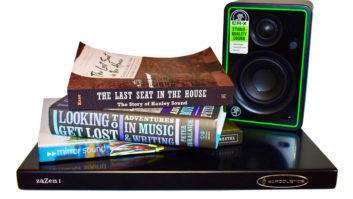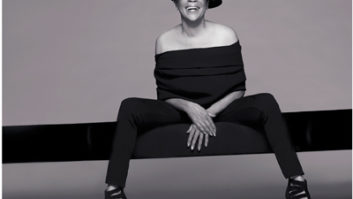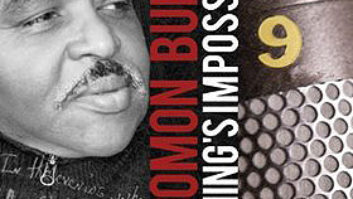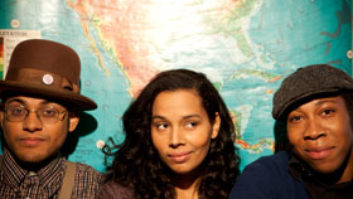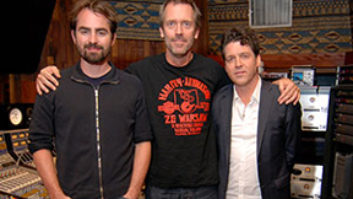Solomon Burke drove to the Sound Factory in Hollywood with only one thing on his mind: “On this session, I did no changes, I did no producing. I just did the singing,” the “Bishop of Soul” explains of his latest critically acclaimed CD, Don’t Give Up on Me (Fat Possum/Anti). “It was a lot of pressure off of me to not be responsible for what the music sounds like or how it’s going to go. ‘This is the way you want it? Okay, here it comes.’ You put the flour out there; I’m going to make the cake. Sorry guys, if you don’t like upside-down cake,” he adds with a laugh. “Next one’s going to be chocolate. So we played bakery, and up popped the goodies.”
Don’t Give Up on Me is just the latest chapter in a long, distinguished career that began in the singer’s hometown of Philadelphia in the early ’60s. He had a number of big hits during that decade — “Cry to Me,” “If You Need Me,” “You’re Good for Me,” “Got to Get You Off My Mind,” “Tonight’s the Night,” “Proud Mary” — but his influence was always greater than his popularity. Mick Jagger is just one of the singers who borrowed from Burke’s powerful, gospel-influenced style. He’s continued to tour and make records through the years (and he owns a chain of mortuaries on the West Coast!), but none have created the stir that Don’t Give Up on Me has in the few months since its release.
For this outing, Burke was assisted by producer Joe Henry and engineer Husky Hoskulds, who recorded the entire 11-song album in a mere four days. It made for brisk sessions, but Henry wouldn’t have had it any other way. “I think time is like closet space — you fill up whatever you have,” he says. “If we had more days, we would have used more days. Truth be told, we could have done it in three.”
Before the recording team even hit the studio, there was already a buzz surrounding Burke’s album: Fat Possum Records’ A&R rep Andy Caulkin had managed to snag new tunes on Burke’s behalf from such legendary songwriters as Bob Dylan, Brian Wilson, Nick Lowe, Elvis Costello, Tom Waits, Van Morrison and Dan Penn. Once in the studio, Burke was surrounded by a number of fine players, including drummer Jay Bellerose, pianist David Palmer, bassist David Piltch, guitarist Chris Bruce and Burke’s longtime organist Rudy Copeland. The Grammy-winning gospel vocal group the Blind Boys of Alabama sang with Burke on the tune “None of Us Are Free,” and Daniel Lanois added his ambient guitar to “Stepchild.”
Though the songs partially dictated the album’s feel, producer Henry — himself a gifted singer/songwriter — had some definite ideas of how the production would sound. “From the beginning, I said pretty plainly, ‘If I’m going to be involved, I have no interest in making a retro soul record. I don’t want any horn sections, I don’t want it to be something that’s overly grand and ornate,’” he explains. “What I really wanted to do was something that was as stripped-down as it could be, so that every nuance, every trail-off of his voice was full-frame. The idea of having new songs from some very outrageous sources — songs that nobody has ever heard before — was very intriguing.”
For his part, Burke says that he was very pleased with the choice of Henry as producer. “Anybody that eats biscuits and gravy is cool with me,” the singer says with a laugh. “He sounded good and he talked good and he was willing to do it. That took a lot of guts, because there were a lot of different producers who would not produce me. Why would you produce someone who is 62 years old that’s been in the business for 50 years? What happens if you fail? What if you don’t come up with a record? Where do you go from there? So, it was a sure shot and a smart move for [Henry], because he knew just how to stay on the wire and to be there and get what he wanted.
“So, I’m hoping that this is it. All we can do is pray and believe. You believe, you receive. You doubt, you do without. So, I’m not doubting and having the faith. It’s a little different for me, because I’m accustomed to hearing more music, more horns and more this and that. But sometimes, less is best.”
That’s also the approach that engineer Hoskulds took during the recording sessions. “For me, there’s not really anything to do except just to make sure that the studio is set up in such a way that you can move quickly,” he reports. “I try to set everything up so that everything is ready to go from the first song; then there’s minimal changing around as we’re going. It’s not really a big setup or a big prep or anything; I just have a lot of coffee and dive in.”
The album was recorded in Studio A at the Sound Factory, which has two medium-sized recording spaces that are in an L configuration, with the control room in the middle. There is a pair of isolation areas that were used but were not as important for an album like this, Hoskulds says. “On this record, it was not as much of an issue, because usually what you get when you’re tracking stands on a record like this; there’s not a lot of chasing your tail. You just don’t have the time to do that. You get the guitar part that’s the guitar part, unless there’s something to fix. It’s good in that sense because it’s not huge by any means, but it’s got a great vibe. And because of the proximity of everyone in the room, it has a vibe that, to me at least, is conducive to getting things done.”
The board in Studio A is a vintage API that’s been highly modified by Sound Factory’s engineering team. “It has a completely custom input module and custom busing matrix,” Hoskulds says, “and it has Flying Faders on it. As far as the sound and flexibility and everything else, it’s a great little setup. And it’s not overwhelmingly large. I don’t have to get up out of my seat to press any buttons. It’s not like an SSL [9k] where you have to kind of go for a short walk to move a fader. Not that I mind the exercise, but still, sometimes you’ve got other things to do,” he says with a laugh.
The entire album was recorded to a Studer A827 at 15 ips with Dolby SR. Hoskulds says that he always likes to bring a fair amount of outboard gear to the party, including a pair of John Hardy M1 mic preamps — which work well with the ribbon microphones that were used almost exclusively on this project — as well as compressors by dbx (163s) and Orban. He also used plenty of Sound Factory’s own impressive selection of outboard gear.
“It’s pretty straightforward, really,” he says. “The stuff that’s most interesting is the stuff that’s going on out in the room. There was not a lot of time for experimenting, so I just try and make it so that things are kind of rolling along.”
Burke’s vocals were recorded with a Neumann U67 through ADL 1500s. “He can sing pretty loud and pretty soft, so I had a couple of compressors on him,” Hoskulds explains. “His voice is still just unbelievable. It was just a matter of trying to get something that was somewhat complementary, while capturing what was going on with as little coloration as possible.”
Where Hoskulds changed things up a bit from the norm was on the drum kit — he brought in an unusual assortment of snares and a couple of different broken cymbals. “I’ve got a couple of old marching snares that are, especially for this project, really a good match to have that ‘Al Green sound,’” he reports. “I have an old Rodgers 10-inch-deep marching snare drum with a wood rim on it, and then I have a Leedy from the Second World War that’s almost all wood. That kind of stuff to me is more interesting than this mic or that mic on the drums.”
That said, Hoskulds miked Bellerose’s drum kit with Coles 4038s for overheads, an E-V RE-20 on the kick drum, a Shure 57 on the top of the snare and an old Grundig dictaphone mic on the bottom. He also threw a Royer ribbon on the hi-hat. Hoskulds believes that the key to drum recording is the position of the overheads: “I’ll position the left-hand Coles overhead in such a way that it will be picking up the floor tom and the ride cymbal,” he explains. “I’ll move ’em around quite a bit to get what’s going on for whatever the drum pattern or vibe.” At times, he’ll also throw a distressed-sounding microphone to catch something interesting for the mix.
Bass is almost always recorded direct when Hoskulds is working on a project, but he will also use a custom tube overdrive box that he built out of a ’60s Ampex quarter-inch tape recorder to add character. Electric guitars were captured with a Coles ribbon mic that goes right into a LA-3A without any EQ. Acoustics were miked with a Neumann 87 into a Hardy M1 mic pre and into an M1 LA-3A combination. “Again, straight to tape, just the mic pre and the compressor,” he says. “I’ll kind of force myself to move the mic rather than grab for the EQ, so I usually don’t use any EQ on the electric or acoustic guitars. With acoustics especially, it’s really amazing how you can improve on the sound just by moving the mic a couple of times.”
While Hoskulds made sure that the recording chain was fairly straight ahead, tracking some of the songs was a challenge. That was especially true, Henry says, because the entire album was recorded live in the studio. “A lot of the songs — and I think the best moments on the record — were one or two takes,” he says. “There are takes when I can listen back and I can hear the process of Solomon taking hold of the song, because it was very new to him, very fresh to him.” The goal here was to challenge the musicians and the singer to be creative and spontaneous and to not over-rehearse and “learn” their parts.
The Nick Lowe song, “Other Side of the Coin,” is a prime example of that approach. “I think we did three or four takes of that and they were all wildly different in character and tone,” Henry recalls. “The first take was very much like an old Nat King Cole trio song — very much like a jazz ballad, very skeletal, which I really loved. But we decided very quickly that it needed to have more of a backbeat than that for Solomon to dig into it. But it was a great example of how it was not a matter of people just having a good moment as musicians or he as a singer, but deciding on where does the song live and how does it best serve the whole of the record.”
Elvis Costello’s contribution, “The Judgment,” initially proved to be a head-scratcher for both Henry and Burke, and they felt extra pressure because Costello was in the studio while they cut it. “I knew that one was going to be the tough one because structurally, it’s odd,” Henry states. “There’s a hanging bar; it’s very orchestral that way. To me, it’s kind of like a Roy Orbison song in that it’s operatic, and the dynamic is grand in that way. That one took the most work to wrestle to the ground.
“I certainly had a moment where, as a producer, I thought, ‘I really need to have a solution here.’ That’s a sobering moment,” he continues. It turns out that having Costello there and available to explain to Burke the feel of the song was the solution that they needed. “It was a really terrific moment,” Henry says. “It ended up being one of my favorite moments of the process, because Elvis is such a fan and he’s never been in the room when someone was recording his song before, which I didn’t know. Elvis talked to him about the phrasing and the odd structure of the song, and that’s how we got a leg up on it.”
Burke has his own special memories of that day: “I’m really overwhelmed by [Costello]. He’s just an unbelievable talent, and for him to personally fly in and supervise the song is just unbelievable. For him to be there and then stay there until two o’clock in the morning — superstars don’t do that. That was just an amazing situation; I was very honored to know that he and his wife even wrote the song for me. He was very caring and very easy and wonderful to talk to. I kept wanting to say, ‘I need your autograph. I need your autograph.’ I was very excited about it.”
Recording “None of Us Are Free” with the Blind Boys of Alabama — fresh from their Grammy win the night before — was another occasion where the control room was packed. “It was a like a baseball team showing up,” Henry jokes. “They had so many people with them, so many well-wishers and handlers. Solomon had some women from the church who brought food for everybody. It was like a scene from a movie with how many people that were in the studio — it was like 45 people in these two rooms.”
In the midst of the hubbub, Burke was learning the song, Henry was working with the Blind Boys’ musical director on the arrangement, and the band was listening in to figure out what was happening with the music. “It was intense, and probably more than the Elvis song, I felt like I was in the hot seat to make sure that all these balls stayed up in the air,” Henry recalls. “Then, when the song happened, it was chilling. At a certain moment, I leaned into Solomon’s vocal mic and counted off the song as a joke to see where everybody was. I didn’t know if everybody had headphones on, I didn’t know if everybody could hear me. I thought everybody was in their own world. I just called the room to order and counted off the song and everybody just fell in. It was really shocking. It kind of blew me back. I felt air leave my body because everybody was there. We did two takes of the song and that was it.”
For any producer, there’s not much better of a feeling. “It was remarkable. It was the end of the fourth day. Solomon was done working, he got up and thanked everybody, and he left. We sat around, had a little bit of scotch and listened to some things back and said, ‘Wow, there really is something.’ It was a really intense four days; it’s kind of a blur when it’s happening, and then you kind of come out of it a day later and you go, ‘I think it happened.’”
Not only did Burke have a chance to put his own producer’s hat aside for this record, it was the first time in a number of albums that neither his daughter nor his son produced one of his sessions. “I kind of get away with things with them,” Burke says with a chuckle. “There was nowhere to run here with this situation. There was a producer sitting there, and he was saying, ‘Let’s go.’ I was waiting for him to come down and say, ‘Hey, man, don’t do this,’ but that never happened.”
In fact, Burke knew from the outset that Henry was the man for this project. “I think I took him out to breakfast and ordered him some gravy with his lox and eggs,” Burke says laughing. “I think from that moment on he said, ‘This is a soul brother; I’ve got to work with this guy. I’ve got to put more gravy in it.’ He brought me a song called ‘Flesh and Blood,’ and I said, ‘Does he want gravy with this?’ So, I put a little gravy on it for him, and I’m sure it wasn’t the way he originally thought it up. He was beautiful. He was a great guy. We had a lot of fun. It went very smoothly.”
